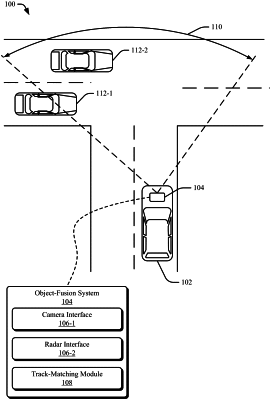| CPC G06V 20/56 (2022.01) [G06F 18/251 (2023.01); G08G 1/166 (2013.01)] | 16 Claims |

|
1. A method, the method comprising:
determining, by an object fusion system of a vehicle and according to first sensor data obtained by a first sensor, a first track of a first object in proximity to the vehicle;
determining, by the object fusion system and according to second sensor data obtained by a second sensor, a second track of a second object in proximity to the vehicle;
maintaining, by the object fusion system, a feasibility matrix indicative of a probability that the first object and the second object are a same object at a given time index and an incompatibility matrix indicative of whether the first track and the second track are historically associated with different objects;
determining whether the incompatibility matrix indicates that the first track and the second track are associated with different objects;
responsive to determining that the incompatibility matrix indicates that the first track and the second track are associated with different objects, determining that the first track and the second track comprise a history of being related to different objects;
responsive to determining that the first track and the second track comprise a history of being related to different objects, adjusting the feasibility matrix by decreasing the probability that the first object and the second object are the same object;
responsive to adjusting the feasibility matrix by decreasing the probability that the first object and the second object are the same object, outputting, to an automotive system of the vehicle, information identifying the first object separate from the second object to avoid a collision between the vehicle and either the first object or the second object;
determining whether the incompatibility matrix indicates, for at least a threshold quantity of consecutive frames, that the first track and the second track are associated with the same object by: incrementing a count associated with the consecutive frames, the count being a temporal indicator of whether the tracks are the same object; and setting the threshold quantity of consecutive frames to a particular value that is based on a measurable accuracy of the first sensor and a measurable accuracy of the second sensor;
responsive to determining that the incompatibility matrix indicates that the first track and the second track are associated with the same object for at least the threshold quantity of consecutive frames, determining that the first track and the second track comprise a history of being related to the same object;
responsive to determining that the first track and the second track comprise the history of being related to the same object, adjusting the feasibility matrix by increasing the probability that the first object and the second object are the same object; and
responsive to adjusting the feasibility matrix by increasing the probability that the first object and the second object are the same object, outputting, to the automotive system, information identifying the same object to avoid a collision between the vehicle and the same object.
|